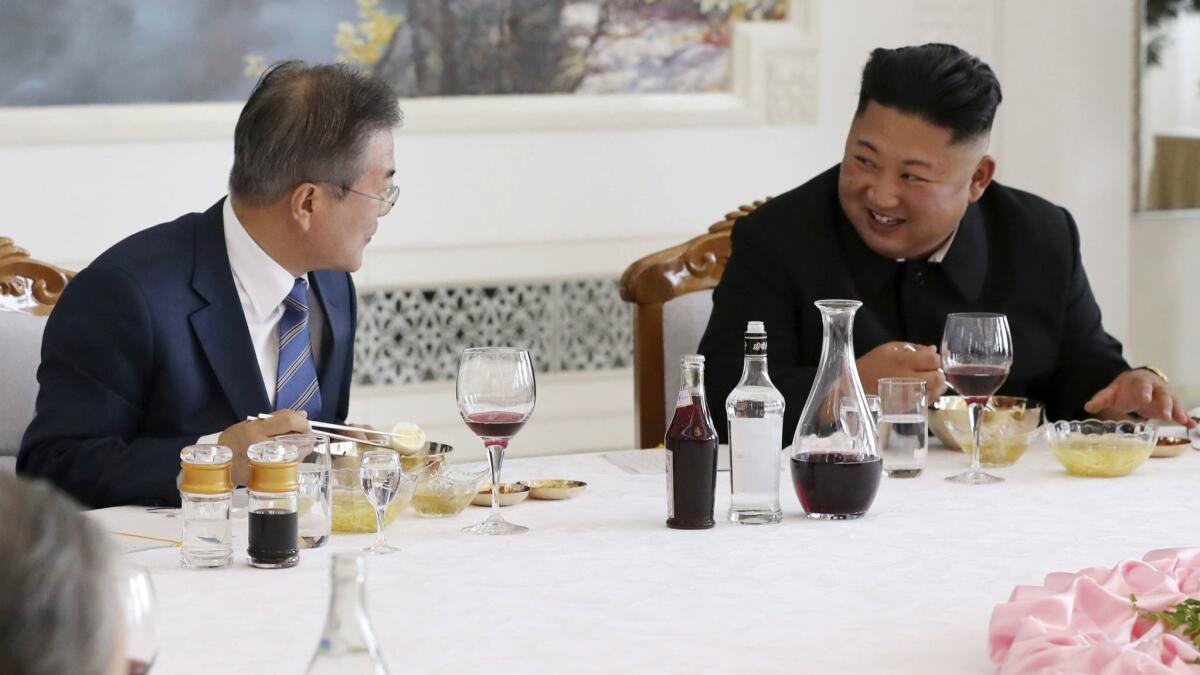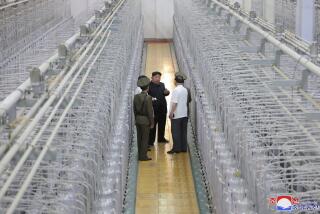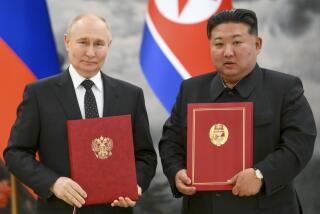U.S. praises North Korea’s offer to shutter missile site and extends invitation for more high-level diplomatic talks

Reporting from Beijing — North Korean leader Kim Jong Un offered Wednesday to shut down a nuclear missile testing and launch site in a development welcomed by President Trump, raising hopes of a second meeting between the two leaders in the quest for a long-sought Korean peninsula denuclearization deal.
Kim made the offer to close down the Dongchang-ri missile testing center and launch pad at a summit in Pyongyang with South Korean President Moon Jae-in. The two signed an agreement to “eliminate all danger” of war on the Korean peninsula, recommitting to the denuclearization of the peninsula.
Kim also agreed to close down the Yongbyon nuclear facility, the first time such an offer has been made by North Korea — but only if the U.S. offers reciprocal rewards. Washington expects North Korea to dismantle its nuclear facilities — in a verifiable manner — before concessions are made.
Kim agreed that international experts would be present to observe the dismantling of the Dongchang-ri facilities.
While some experts suggested Kim was giving up facilities no longer important to him, given North Korea’s development of nuclear missiles, Trump’s instantaneous positive reaction on Twitter kept the door open to a possible new summit with Kim.
Kim last week requested a second summit, after the historic first meeting in Singapore in June, the first between U.S. and North Korean leaders. U.S. officials last week said preparations were underway for a second meeting to go ahead.
A second summit may hinge on a meeting between Trump and Moon expected next week, where Moon is to brief Trump on his summit with Kim.
Calling the developments “very exciting.” Trump tweeted Wednesday that “Kim Jong Un has agreed to allow Nuclear inspections, subject to final negotiations, and to permanently dismantle a test site and launch pad in the presence of international experts. In the meantime there will be no Rocket or Nuclear testing.” He added that the remains of U.S. servicemen killed in the Korean War would continue to be returned to the U.S.
U.S.-North Korea denuclearization talks stalled in recent months. Trump last month canceled a visit by Secretary of State Michael R. Pompeo to North Korea for talks, citing lack of progress.
On Wednesday, Pompeo congratulated the two leaders for “the successful outcome of their summit meeting in Pyongyang,” he said in a statement. “We welcome President Moon and Chairman Kim’s reaffirmation of the Singapore joint statement of complete denuclearization of the Korean peninsula, including the permanent dismantlement of all facilities at Yongbyon…. On the basis of these important commitments, the United States is prepared to engage immediately in negotiations to transform U.S.-DPRK relations.”
Pompeo said he invited his North Korean counterpart, Foreign Minister Ri Yong Ho, to meet him next week in New York during the U.N. General Assembly meeting.
The leaders of the two Koreas appeared to move significantly closer at Wednesday’s meeting: Kim accepted Moon’s invitation to visit Seoul in the near future, in what would be the first visit to the country by a North Korean leader. The two countries also decided to make a joint bid to host the 2023 Olympic Games.
They also signed a 55-page joint military agreement designed to ease tensions on the border, including creating a border buffer zone, removing landmines from the demilitarized zone, creating a no-fly zone along the DMZ and shutting down 11 guard posts.
Kim gave Moon a welcome that was full of photo opportunities and symbolic moments. He met Moon at the airport Tuesday and hugged him on the tarmac before the two drove through the streets of Pyongyang in an open-topped limousine as flag-waving crowds cheered.
The summit saw Moon eating North Korea’s most iconic dish, a meal of cold handmade buckwheat noodles called naengmyeon, at lunch Wednesday, with Kim later joking that he was concerned Moon had to hurry the meal because of the summit agenda.
‘”You have to slow down when you eat buckwheat noodles,” Kim said, showing a softer side in contrast to his global image as a reclusive, ruthless and sometimes eccentric figure.
In another deeply symbolic move, Kim invited Moon to accompany him Thursday to visit Mt. Paektu , a volcano on the border with China that has great historical and cultural significance for both North Korea and South Korea.
Standing side by side at a joint news conference after their talks Wednesday, both Moon and Kim extolled their agreement as an important breakthrough for peace.
Kim called it a historic agreement that ended decades of hostility between the Koreas.
“We will be ushering in a new era of peace at a faster pace,” Kim said. “We have agreed to make the Korean Peninsula a land of peace that is free from nuclear weapons and nuclear threat.
“The road to our future will not always be smooth and we may face challenges and trials we can’t anticipate. But we aren’t afraid of headwinds because our strength will grow as we overcome each trial based on the strength of our nation.”
Moon said Kim had shown he was committed to full denuclearization.
“I would like to offer my deepest gratitude to him for his courageous determination,” Moon said. He said progress on improved relations between the Koreas had not slowed in the months since he and Kim met in April and May.
“It looks as if it is going too fast, however it is not, because we have been preparing for this for a very long time and it is just unfolding before our eyes.
“This path to complete denuclearization will be implemented and will be realized.”
Kim said the two Koreas would make their way to peace, with no fears about external forces.
Trump recently tweeted and he and Kim would “both prove everyone wrong! There is nothing like good dialogue from two people that like each other!” That tweet on Sept. 9 came after a military parade commemorating the 70th anniversary of the founding of North Korea that did not include the usual display of intercontinental ballistic missiles, considered a sign of restraint by Kim.
Trump’s national security advisor, John Bolton, said a day later that the U.S. was waiting for North Korea to denuclearize, but could not make the country do so.
“They’re the ones that have to take the steps to denuclearize, and that’s what we’re waiting for,” he said in a speech to the conservative Federalist Society. U.S. officials want concrete details on North Korea’s nuclear arms, with a verifiable list of nuclear facilities and transparency on steps to dismantle them.
Kim fell short of that requirement Wednesday. Any future summit between Trump and Kim would have to make progress on that sticking point in order to break the long deadlock over North Kora’s nuclear weapons. If neither side budges, the future efforts toward denuclearization may stall again, as they so often have in the past.
North Korea has been brought to the negotiating table by crippling U.N. sanctions. In April, Kim announced he was changing direction from focusing on the development of nuclear weapons along with the economy, to a sole focus on the economy.
China has played a key role in maintaining pressure on North Korea through sanctions. But relations between Washington and Beijing have deteriorated sharply with the escalating trade war between the countries, and Trump on Monday announced 10% tariffs on another $200 billion of Chinese imports. China responded by slapping tariffs of 5% to 10% on $60 billion of U.S. goods and accusing Washington of acting in bad faith.
Chinese Foreign Ministry spokesman Geng Shuang Wednesday welcomed progress made at the summit between North Korea and South Korea, saying the countries broke important new ground.
“We welcome it and highly appreciate active efforts by the two sides,” he said.
Twitter: @RobynDixon_LAT
UPDATES:
2 p.m.: This article was updated with a statement from Secretary of State Michael R. Pompeo.
This article was originally published at 8:15 a.m.
More to Read
Sign up for Essential California
The most important California stories and recommendations in your inbox every morning.
You may occasionally receive promotional content from the Los Angeles Times.










